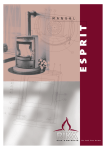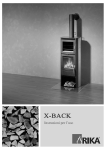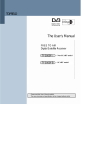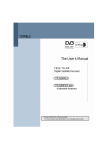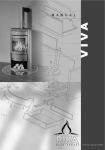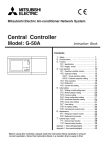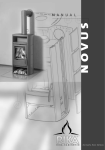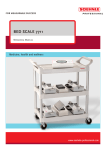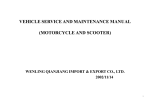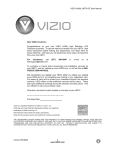Download RIKA Alpha II Instruction manual
Transcript
ALPHA II Instruction Manual Fig. 1 Fig. 2 Fig. 3 Version: Stahlmantel Version: Steel casing Versione: rivestimento in acciaio Version: Manteau en acier Fig. 4 Fig. 5 Fig. 6 Version: Speckstein Version: Whetstone Versione: rivestimento in steatite Version: stéatite Kohlendioxid Carbon dioxide Anidride carbonica Dioxyde de carbone Sauerstoff Oxygen Ossigeno Oxygène CO Fig. 7 ≈7c H 2O O 2 CO 2 2 m Fig. 8 25 c m ≈ 1,6 kg Fig. 10 Fig. 9 Fig. 11 Fig. 12 Wasser Water Acqua Eau L I S T O F C O N T E N T S Overview of technical data and spare parts 19 1. I M P O R TA N T I N F O R M AT I O N General warning and safety instructions 20 Before installing the appliance 20 - 21 INFORMATION ON HEATING PRACTICE Suitable fuels and quantities 22 Fuel quantities 22 Maximum fuel quantities 22 Clean combustion 23 Burning of wood 23 2 . I N S TA L L AT I O N O F T H E A P P L I A N C E Changing the draw plate 24 Inserting the whetstone panels 24 Connecting to the chimney 24 3 . O P E R AT I O N Firing up 25 The ash drawer 26 Actuation of the vibrating grate 26 Damper settings for nominal heating performance 26 4. CLEANING AND MAINTENANCE General maintenance 27 TROUBLESHOOTING What to do if . . . ? 28 5. G UARANTE E We guarantee 55 - 56 Guarantee card 55 - 56 E X P L A N A T I O N Important instructions Practical advice Use the fold out plan for assistance 18 O F S Y M B O L S TECHNICAL DATA Dimensions (mm) and weights (kg) Height Width Depth of the corpus Weight with steel casing Weight with stone casing Smoke flue outlet diameter Nominal heating power (DIN 18891) Lowest heating power Space heating capacity (m³) – dependent on house insulation Fuel flow Efficiency CO2 content CO emission rel. 13% O Dust emissions 905 516 395 115 155 130 7 kW 3,5 kW 70-190 1,4 kg/h 78,9 % 10,2 % 734 mg/Nm3 29 mg/Nm3 Exhaust gas values for multiple use of the chimney in accordance with DIN 4705, Part 3/chimney dimensions to DIN 4705, Part 2 Exhaust gas mass flow g/s 8,68 Exhaust gas temperature °C 268,5 Minimum feed pressure at rated useful 12 heat Pa 1. I M P O R TA N T I N F O R M AT I O N GENERAL WARNING AND SAFETY INSTRUCTIONS ➧ bited. The introductory general warning and safety instructions must be unconditionally observed ➧ ➧ ➧ Only an approved means of transport, distancefrom the heating appliance - E NG LI S H Danger of fire! be used to transport your heating appliance. ➧ Your heating appliance is not suitable for When operating your heating appliance, the use of easily flammable and explosive use as a ladder or supporting platform. ➧ Frames or racks for drying items of clothing, or similar, must be placed at an adequate with adequate load carrying capacity must ➧ Do not dry items of washing on the appliance. Before commissioning the heater, read this handbook thoroughly in its entirety. ➧ The placing of non-heat resistant objects on or near the heating appliance is prohi- substances in the same or an adjoining room is prohibited. The burning of fuel releases heat energy, leading to considerable heating of the surface of the heating appliance, the doors, BEFORE INSTALLING THE APPLIANCE the door and operating handles, the door 1 .1 Floor load capacity: glazing , the smoke flue and in some circum- Before installing the appliance, make sure stances, the front wall of the appliance that the load carrying capacity of the floor Contact with these components without sub-structure is adequate to withstand the appropriate protective wear, such as heat weight of the heater. protective gloves, or actuating means, must be avoided. ➧ SAFETY DISTANCES (Minimum distances) Fig. 2 Make your children aware of these special 1. For non-combustible objects a > 100 mm b > 400 mm dangers and ensure that they do not have 2. For combustible objects and supporting walls in reinforced concrete a > 200 mm b > 800 mm c > 200 mm access to the appliance when it is in use. ➧ Burn exclusively the approved heating materials stated in the section on “Clean 1 . 2 Smoke flue connection combustion”. ➧ c > 100 mm Smoke flues are a special source of danger The combustion or introduction of readily in view of the poisonous gas outlet and fire combustible or explosive matter, such as hazard. Engage the services of a franchised empty spray cans and the like, into the dealer for their location and installation. combustion chamber, or their storage in close proximity to the appliance is strictly When connecting your flue to the heater in forbidden, due to the danger of explosion. the vicinity of wood clad walls, please observe ➧ the appropriate installation guidelines. No loose or bulky or easily flammable clothing should be worn when attending the heating process. 20 1.3 1.7 Be sure to note the build-up of flue gases When opening the doors on your appliance under unfavourable weather conditions and when actuating the controls, use the (Weather inversion) and the flue draft tools provided with your heater for these behaviour. purposes, i.e. the protective gloves and the If too little air for combustion is taken in, operating tools. this can lead to fumes in the room in which escape of flue gases. In addition, damaging Heating appliance - Construction type 1 deposits can be formed in the appliance (BA 1): and in the chimney. This must only be operated with the fire- In the event of the escape of fumes, let the box door closed. fire go out and check that all the air inlet 1.9 openings are unobstructed and that the The fire box door must only be opened for flue gas ducting and flue are clean. In case the charging of fuel and must then be clo- of doubt, advise a registered chimney sed again, otherwise this can lead to the sweep, since inadequate draft conditions endangering of other fire places/heating may be associated with your chimney. appliances also connected to the chimney. 1.4 1 . 9 .1 Before adding new fuel, rake the existing When the appliance is not being used, the incandescent residue into a single bed of firebox door should be kept closed. material. 1 .10 1.5 The use of wet material as fuel, with too Only use the tool specified in our range of much throttling , can lead to sooting-up of accessories for the purpose of raking the the chimney, i.e. to the deposit of easily material together and ensure that no glowing flammable substances such as soot and tar, ashes fall from the combustion chamber possibly leading to a chimney fire. onto combustible material. Should this occur, close all air inlets and 1.6 flaps. Call the fire service and withdraw to a Brown coal briquettes, separated by about place of safety, together with all the a finger’s breadth should be laid in a single occupants of the building. layer on the glowing material. Caution: Due to the size of the fire box door, it is necessary, particularly during heating up, when the flames are high, not to open the door too abruptly, in order to prevent the emergence of flames from the appliance. 21 E NG LI S H 1.8 the appliance is located, or result in the I N F O R M AT I O N O N H E AT I N G P R A C T I C E SUITABLE FUELS AND QUANTITIES MAXIMUM FUEL QUANTITIES Your appliance is basically suitable for Wood: (Fig. 9, 10) the burning of dry chopped firewood. In 2 logs addition, you can burn fuels such as wood Brown coal briquettes: briquettes and brown coal briquettes. 3 items E NG LI S H Use only dry material for burning. The approx. 0.8 kg approx. 0.5 kg burning of refuse of any kind, particularly Wood briquettes (Broken): plastics, will damage your appliance and the 2 items chimney and is prohibited by the statutory Control of the power output of your appli- regulations on emissions. ance is obtained by means of the air intake approx. 0.8 kg damper. Since the power of your firing FUEL QUANTITIES appliance is also dependent on the chimney The appliance is designed with a flat firing draft, this air intake damper must be regula- layout, due to its style of construction. This ted in accordance with your own experience means that only one layer of fuel must be of the operation of the system. placed on the existing glowing embers Operation of the secondary air intake regulator, the primary air intake regulator and the vibrating grate lever, must only be undertaken using the claw tool provided. when re-charging. Please note, that if a greater quantity of fuel is added to your firing appliance, it will output more heat and will heat up in excess of the intended design limits. This may result in damage to the appliance. 22 Satisfying the challenges of our time 2. THE CORRECT QUANTITY AND SIZES OF WOOD FUEL implies the acceptance of responsibility. The conservation of nature is now one of ➧ our greatest challenges. Our products are ting. The material is overloaded and your developments that correspond to the latest appliance generates undesirable flue gas state of the art technology. This is an essen- values. tial prerequisite for the clean, efficient Too much wood fuel results in overhea- Too little wood fuel, or the use of logs ➧ and law-abiding functioning of our firing that are too large, results in the firing appliances. CLEAN COMBUSTION ting temperature. The following are important to the achieve- values. This also results in undesirable flue gas ment of clean combustion: Correct quantity of wood fuel: (Fig. 10) ➧ 1. THE WOOD TO BE BURNED MUST BE DRY AND UNTREATED. (Fig. 11) For wood ≈ 1.6 kg (2 logs) per layer Standard value ‹ 15 % rel. humidity in the (Standard value), with a nominal heating wood. power of 6 kW. Lowest heating power (3 kW) ≈ 0.8 kg 2 - 3 years drying and well ventilated storage. (1 log). A chimney-installed firing appliance is not a “refuse incinerator”. The burning of refuse and non-permitted material such as plastic, treated wood, etc., renders the guarantee null and void! Further consequences are damage to and soiling of the equipment and chimney - and of the environment! Caution: Only wood briquettes and brown coal briquettes are to be burned in your firing appliance. Under no circumstances must plastics, treated wood materials (e.g. chipboard), pit coal and textiles be burned. BURNING OF WOOD (Fig. 8) The clean burning of wood corresponds to the same chemical process as natural rotting , i.e. the liberated CO 2 (carbon dioxide) does not increase or debit the balance of CO 2 in the atmosphere. Plant Growth Wood CO 2 - content Rotting of wood Burning of wood 23 E NG LI S H appliance not reaching the optimum opera- 2 . I N S TA L L AT I O N O F T H E A P P L I A N C E CHANGING THE DRAW PLATE (Fig. 5) 2. Chisel out (or drill out) the hole in the If the draw plate or the draw-deflector is to 3. Brick in the shell lining. masonry work. be replaced on your firing appliance, lift the First seal the shell lining with mineral wool. Then fill the area with heat-resistant mortar or equally suitable filler. draw plate slightly to the side and remove the side fireclay component. You can now tilt the draw plate and remove E NG LI S H it from the firebox opening. 4. When the mortar has hardened and after the filling and smoothing , position Before initial commissioning or after re-locating the appliance, cleaning and servicing, make sure that the draw plate (Fig. 5, Part 18), and the wood collector (Fig. 5, Part 21) are correctly positioned. When using a flue with a throttle flap, this must be open. the base plate and floor protection (Carton). 5. The unit can now be lifted carefully onto the base plate. Under no circumstances must the appliance be pushed over an unprotected floor. On this firing appliance, it is necessary to ensure that the chimney draft reaches at least the prescribed value (> 0.8 mbar). If there is a problem in achieving this value, contact your chimney sweep/maintenance engineer. A suitable covering for the floor is provided by using strong corrugated paper, carton or, for example, a piece of used carpet. The aplliance can be safely pushed over such a protective layer. If you do not use our original flue compo- INSERTING THE WHETSTONE PANELS nent for the chimney connection, then we Insert the lugs on the pre-mounted carrier recommend the use of a tube manufactured plate of the (Right or left) whetstone panel from steel sheet at least 2 mm thick. Under (With the opening pointing downwards) no circumstances must the connection into the cut-out slots on the oven side wall component protrude into the chimney and allow the whole panel unit to slide duct itself! Seal the gap between the flue slowly downwards, whilst pressing against pipe and the shell lining with a ceramic seal. the oven body. Insert the opposite panel by the same method. The installation must satisfy the relevant safety and building regulations. Please contact your registered chimney sweep/maintenance engineer. Who will be pleased to advise you. CONNECTION TO THE CHIMNEY On establishing a new connection in a brick-built chimney, the following proce- If you use a “system” chimney (e.g. glazed fireclay) - we would advise you to follow precisely the connection instructions of the manufacurer. dure is recommended: 1. Measure out and mark-off the position of the chimney connection (if necessary, taking account of the base plate thickness). 24 3 . O P E R AT I O N FIRING UP (Fig. 12) 3. In order to suppress the emission of pollu- Now ignite the paper. Wait until the soft- tants as far as possible, we would ask you - wood chippings are burning well. for the sake of the environment - to adhere Several minutes later, close the vibrating to the following instructions for heating up grate actuator and the primary air damper. your firing appliance. A few minutes later, adjust the secondary air damper to the ideal settings. 1. low atmospheric pressure prevails, it is When the burning has finished, lay about recommended that initially you burn some 1.8 kg of wood (2 logs) in the firebox. Open paper, to “drive” the coldness from the the vibrating grate actuator and the prima- appliance and the chimney. ry air damper, until the wood is burning well (approx. 2 min.). The secondary air damper 2. should remain at the ideal setting. For the purpose of heating up, first lay For each further layer of fuel, proceed in some uncoated paper on the floor of the the same way. firebox and on top of this place 0.5 kg of 5. softwood chippings and 1.4 kg of wood (2 The remnants of the combustion on the logs). firebox floor are the mineral components Pull the vibrating grate actuator (Part 23) of the wood (approx. 1 %). fully out and open the primary air damper This ash is an excellent fertiliser for all the (Part 6) and the secondary air damper plants in the garden, because it is a purely (Part 4). natural product. However, the ash should first be left to accumulate and then be Please do not use gloss paper or paper from magazines. These types of paper do not burn well and they generate very poisonous substances in the flue gases. “quenched” with water. 25 E NG LI S H 4. If your appliance and chimney are cold, or if Caution: Burning embers can still be present in the ash. Therefore only empty the ash into a non-flammable container and do not place the ash drawer on flammable surfaces. THE ENAMEL APPLIED TO YOUR HEATING APPLIANCE BECOMES FULLY HARDENED THROUGH HEATING DURING INITIAL USE. - Do not touch the surface during initial heating. It will still be soft. E NG LI S H - To draw off the fumes that are liberated, ensure that the area housing the appliance is well ventilated and do not prepare food in the vicinity of the appliance. ACTUATION OF THE VIBRATING GRATE The translatory motion of the vibrating grate actuator causes the ash to be transfe- - Heat up the appliance thoroughly - this will shorten the hardening time. red from the combustion chamber to the ash drawer. - The hardenimg of the surface will be complete after several routine heating operations. This leaves the path clear in the combustion chamber for primary air - necessary for the heating-up phase. Please refer to Chapter 1 for details of the wood fuel to be burned and the correct heating procedure. It is not necessary to activate the vibrating grate during the heating-up phase. DAMPER SETTING FOR NOMINAL HEATING PERFORMANCE THE ASH DRAWER In order to avoid excessive thermal stressing of the grate, the ash drawer should be Wood/ Wood briquettes Brown coal briquettes. Closed 1/2 open Secondary air 1/3 open 1/4 open Vibrating grate Closed Open Fuel emptied regularly. Primary air Never heat up the appliance with the ash drawer open → Danger of over heating → Guarantee is rendered null and void. The setting “Primary air fully open” must only be used as a heating-up setting. 26 4. CLEANING AND MAINTENANCE The black surface of the appliance is highly GENERAL MAINTENANCE heat-resistant and need only be cleaned Your ALPHA II appliance has been designed using a cloth (dampened if necessary). If by our development team with the the surface needs to be restored, then use concepts of minimum maintenance and only the original type of lacquer as stocked long operating life very much in mind. by your specialist dealer. Certain cleaning operations and the checkin of seals are necessary from time to time. a large extent on the quality of the wood Clean off dust deposits from the convec- you burn and frequency of use. tion air openings regularly, using a source of suction. All maintenance and cleaning work must be undertaken exclusively when the appliance has completely cooled down. Before the start of a new heating season, the appliance should be thoroughly cleaned in order to avoid strong odours during operation. A REMINDER CLEANING THE FLUE GAS PATHS (Once per year) Only use wood that has been properly stored, is dry and untreated. Remove the fire tubes. Use the correct quantity of fuel. Brush off/suck out any deposits of soot Poor fuel material can more than double the number of maintenance activities that become necessary. and dust in the firing components and the fire tubes. At the start and finish of a heating period, check the seals on the combustion cham- SURFACE CONDITION AND CLEANLINESS ber door and on the ash drawer. The glass in the doors can be cleaned with please order the appropriate replacement a specially prepared cleaning medium. This items. If the seals are damaged or very worn, then is obtainable from your specialist dealer. If the glass becomes very severely sooted, Only intact seals will guarantee the proper functioning of your firing appliance. Loose seals should be reattached using Thermohit seal adhesive. this could be caused through burning damp wood. 27 E NG LI S H CONVECTION AIR OPENINGS The time between inspections depends to TROU B L ESHOOTI NG What to do if ...? Problem Reason Solution Basically: From time to time (depen- 1. Ceramic glass pane soots up ding on usage), each glass too quickly pane must be cleaned using a special glass cleaner (e.g. the “Thermohit” E NG LI S H brand) ➧ Poor draft Discuss with chimney sweep/maintenance engineer (if necessary raise the chimney or fit a chimney cap). ➧ Incorrect regulation Adjust the air damper in accordance with the operating instructions (if the secondary air is closed-off, the glass pane will soot up very quickly, but under normal specified operating conditions, it may burn off again) ➧ Too much fuel See item “Max. fuel quantities” ➧ Wet wood See item “Clean combustion” - if necessary, use wood briquettes (these are uniformly dry) ➧ Wrong fuel or: The glass panes dirty quicker when using coal briquettes, than when using wood ➧ Chimney draw is inadequate See item ”Inform. on heating practice.” ➧ Appliance is sooted up inside See item “Cleaning and maintenance” ➧ Weather influence See item “Firing up” burn properly ➧ Incorrect heating up See item “Firing up” 4. Appliance smells ➧ Burning-in phase See item “Operation” (Hardening of ➧ Appliance is dusty/dirty See item “Convection air openings” ➧ Burning-in phase not See item “Operation” (Hardening of completed properly the lacquer) Chimney draw inadequate, Check connections and re-seal if flue connection not sealing necessary 2. Appliance does not draw properly 3. Appliance does not strongly and there is smoke outside 5. Lacquer does not the lacquer) harden 6. Escape of fumes on relaying and during ➧ the heating phase If, after referring to this troubleshooting guide, your problem persists, contact your specialist dealer or registered chimney sweep/maintenance engineer. 28 ENGLISH 8 . W A R R A N T Y These warranty conditions Germany and Switzerland. apply to The warranty excludes WEARING PARTS such as glass, coating, surface coatings (e.g. handles, panels), seals, fire trough, grates, draught plates, deflector plates, combustion chamber liners (e.g. fireclay), ceramics, natural stone, ignition elements, sensors, combustion chamber sensors and temperature controller. Damage arising from nonobservance of the manufacturer’s instructions for operation of the unit is also excluded (e.g. overheating, use of non-approved fuels, incorrect intervention in the stove, electrical excess voltage, a chimney draught set incorrectly for the stove, nonperformance or deficient maintenance and cleaning, incorrect operation by the user or third parties, etc.) or caused by such. Any costs incurred by the manufacturer due to unjustified warranty claims are to be charged to the claimant. Austria, For the purpose of timely damage limitation, the warranty claim on the part of the claimant is to be enforced at the RIKA dealer in writing using the invoice and stating the purchase date, model name, serial number and reason for complaint. WARRANTY 5 years on the welded stove body. The warranty only covers defects in materials and workmanship as well as delivery of spare parts free of charge. Labour and travel times are not included in the manufacturer’s warranty. Only use spare parts recommended or supplied by the manufacturer. Loss of warranty on nonobservance! THE WARRANTY DOES NOT AFFECT THE STATUTORY WARRANTY PROVISIONS. The precondition for the warranty is that the stove has been installed and commissioned properly according to the Instructions for Use valid at the time of purchase. Connection must be performed by a specialist for such stoves. - 18 - - 19 - 2010/12/09 GGAURAARNATNI TE E E / G A R A N T I E Stamp Stamp Marque Marque Customer/Client: Customer/Client: To/A: To/A: - 20 -



















